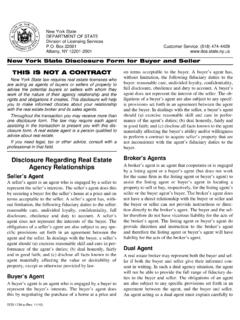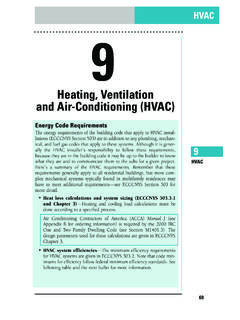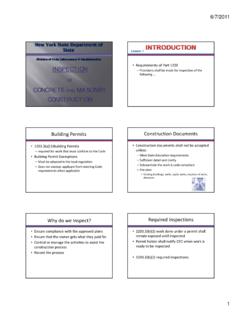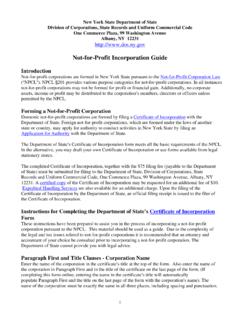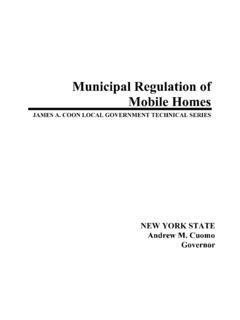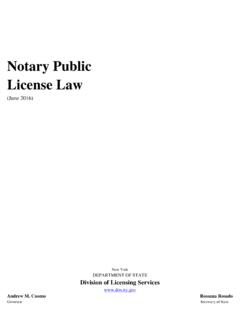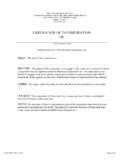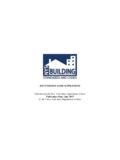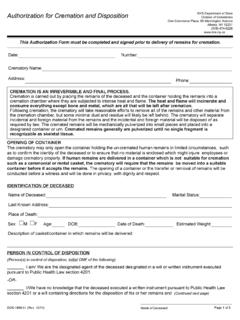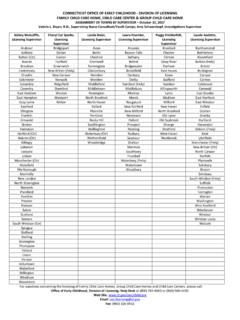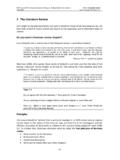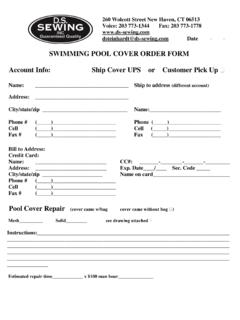Transcription of Current Requirements for Swimming Pools …
1 Current Requirements for Swimming Pools Contained in the Uniform Fire Prevention and Building Code (Uniform Code). April 2011. Introduction The State Uniform Fire Prevention and Building Code (the Uniform Code ) is promulgated by the State Fire Prevention and Building Code Council (the Code Council ) pursuant to Article 18. of the Executive Law. The Uniform Code includes provisions contained in Parts 1219 to 1228 of Title 19 of the New York Code, Rules and Regulations (the NYCRR ) and the provisions contained in the publications that are mentioned in Parts 1220 to 1227. Those publications include the 2010 editions of the Residential Code of New York State, the Building Code of New York State, the Plumbing Code of New York State, the Mechanical Code of New York State, the Fuel Gas Code of New York State, the Fire Code of New York State, the Property Maintenance Code of New York State, and the Existing Building Code of New York.
2 The Uniform Code includes a number of provisions relating to Swimming Pools . This document is intended to summarize the Requirements for Swimming Pools currently found in the Uniform Code. Please note that local laws regarding fencing and other safety Requirements for Swimming Pools may be more restrictive than Requirements for Swimming Pools contained in the Uniform Code. If you are considering the purchase of a Swimming pool, you should review the Uniform Code provisions summarized in this document and, in addition, you should consult the local laws, ordinances, codes and regulations of the municipality where the pool is to be installed for any further Requirements Definition of Swimming Pool . The term Swimming pool is defined in the Uniform Code as any structure, basin, chamber or tank which is intended for Swimming , diving, recreational bathing or wading and which contains, is designed to contain, or is capable of containing water more than 24 inches (610 mm) deep at any point.
3 This includes in-ground, above-ground and on-ground Pools ; indoor Pools ; hot tubs;. spas; and fixed-in-place wading Pools . 1. NOTE: A pool which is capable of containing more that 24 inches of water is a Swimming pool (and is subject to all applicable Uniform Code provisions relating to Swimming Pools ). even if the pool is filled to a depth of less than 24 inches. Barrier Requirements : Outdoor Residential Swimming Pools An outdoor residential Swimming pool must be provided with a barrier which completely surrounds the Swimming pool and obstructs access to the Swimming pool. The barrier may consist of a fence, a wall, a building wall, or any combination The barrier must be at least 4 feet (48 inches) high, and must satisfy certain specified Requirements (which are discussed in more detail below).
4 Access gates must satisfy the Requirements applicable to barriers, as well as certain additional Requirements (which are discussed in more detail below). In addition, access gates must be securely locked with a key, combination or other child-proof lock sufficient to prevent access to the Swimming pool through such gate when the Swimming pool is not in use or supervised. NOTE: In general, the barrier Requirements discussed in this document apply to all Swimming Pools , without regard to the date of construction or installation of the pool. 3. NOTE: As mentioned above, the definition of Swimming pool includes hot tubs and spas. However, a hot tub or spa with a safety cover that complies with reference standard ASTM F. 1346, entitled Standard Performance Specification for Safety Covers and Labeling Requirements for All Covers for Swimming Pools , Spas and Hot Tubs, is exempt from the barrier Requirements discussed here.
5 NOTE: The principal purpose of the Uniform Code's barrier Requirements is to make Swimming Pools inaccessible to young children. The specific Requirements discussed below are intended to prevent a child from crawling under the barrier, fitting through the barrier, or climbing over the barrier. The Requirements for access gates are intended to prevent a child from opening an access gate. Barriers provided for outdoor residential Swimming Pools must satisfy the following Requirements : The barrier must completely surround the Swimming pool and must obstruct access to the Swimming pool. The barrier must be at least 4 feet (48 inches) high. The space between the bottom of the barrier and the ground cannot exceed 2 inches. In the case of an above-ground pool, the barrier may be at ground level or mounted on top of the pool structure; however, if the barrier is mounted on top of the pool structure, the space between the top of the pool structure and the bottom of the barrier cannot exceed 4 inches.
6 See Figure on Page 3. Any opening in the barrier must be small enough to prevent the passage of a 4-inch- diameter sphere through the opening. See Figure on Page 3. A barrier that does not have openings, such as a masonry or stone wall, cannot contain indentations or protrusions (except for normal construction tolerances and tooled masonry joints). Where the barrier is composed of horizontal and vertical members and the distance between the tops of the horizontal members is less than 45 inches: o the horizontal members must be located on the Swimming pool side of the fence;. o the spacing between vertical members cannot exceed inches; and o the spacing within any decorative cutouts in vertical members cannot exceed inches. See Figure below.
7 Where the barrier is composed of horizontal and vertical members and the distance between the tops of the horizontal members is 45 inches or more: o the spacing between vertical members cannot exceed 4 inches; and o the spacing within any decorative cutouts in vertical members cannot exceed inches. See Figure below. The figures on this page appear with the permission of the International Code Council. These figures may not be reproduced without the express written consent of the International Code Council. If a chain link fence is used as the barrier, the mesh size cannot exceed square unless the fence is provided with slats fastened at the top or the bottom which reduce the openings to not more than inches. See Figure above. Where the barrier is composed of diagonal members, such as a lattice fence, the opening formed by the diagonal members cannot exceed inches.
8 Access gates must satisfy the Requirements stated above, and with the following additional Requirements : o All gates must be self-closing. In addition, if the gate is a pedestrian access gate, the gate must open outward, away from the pool. o All gates shall be self-latching, with the latch handle located within the enclosure ( , on the pool side of the enclosure) and at least 40 inches (1016 mm) above grade. In addition, if the latch handle is located less than 54 inches (1372 mm). from the bottom of the gate, the latch handle shall be located at least 3. inches (76 mm) below the top of the gate, and neither the gate nor the barrier shall have any opening greater than inch ( mm) within 18. inches (457 mm) of the latch handle. o All gates shall be securely locked with a key, combination or other child proof lock sufficient to prevent access to the Swimming pool through such gate when the Swimming pool is not in use or supervised.
9 A building wall can form part of the required barrier. However, where a wall of a dwelling serves as part of the barrier, at least one of the following Requirements must be satisfied: o the pool must be equipped with a powered safety cover in compliance with reference standard ASTM F1346, entitled Standard Performance Specification for Safety Covers and Labeling Requirements for All Covers for Swimming Pools , Spas and Hot Tubs; or o all doors with direct access to the pool through that wall must be equipped with an alarm which: 1. produces an audible warning when the door and its screen, if present, are opened, 2. sounds continuously for a minimum of 30 seconds immediately after the door is opened, 3. is capable of being heard throughout the house during normal household activities, 4.
10 Automatically resets under all conditions, and 5. is equipped with a manual means, such as touchpad or switch, to deactivate the alarm temporarily for a single opening (such deactivation cannot last for more than 15 seconds, and the deactivation switch[es] must be located at least 54 inches above the threshold of the door); or o other means of protection, such as self-closing doors with self-latching devices, which are approved by the governing body and which afford a degree of protection not less than the protection afforded by the powered safety cover and door alarm described above, must be provided. In the case of an above-ground pool, the pool structure itself can serve as a part of the required barrier, provided that the pool structure is sufficiently rigid to obstruct access to the pool.
